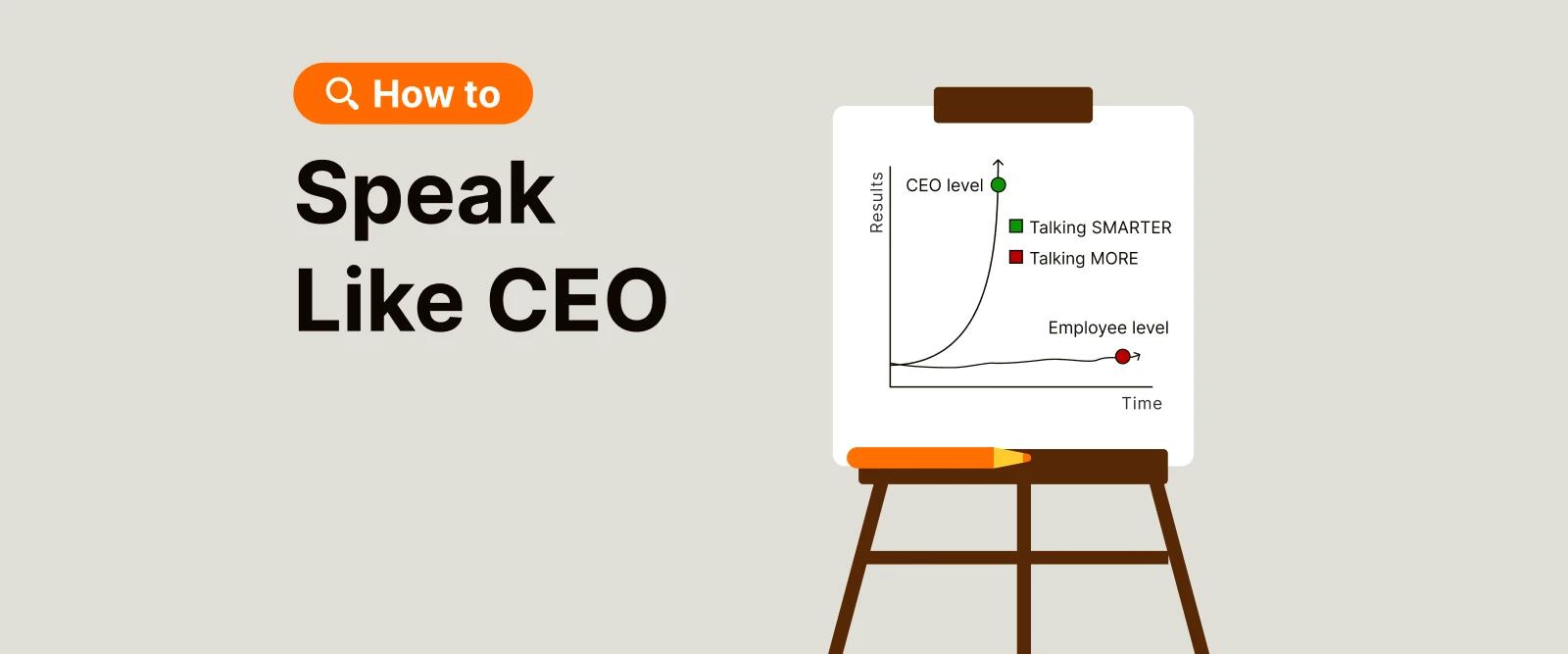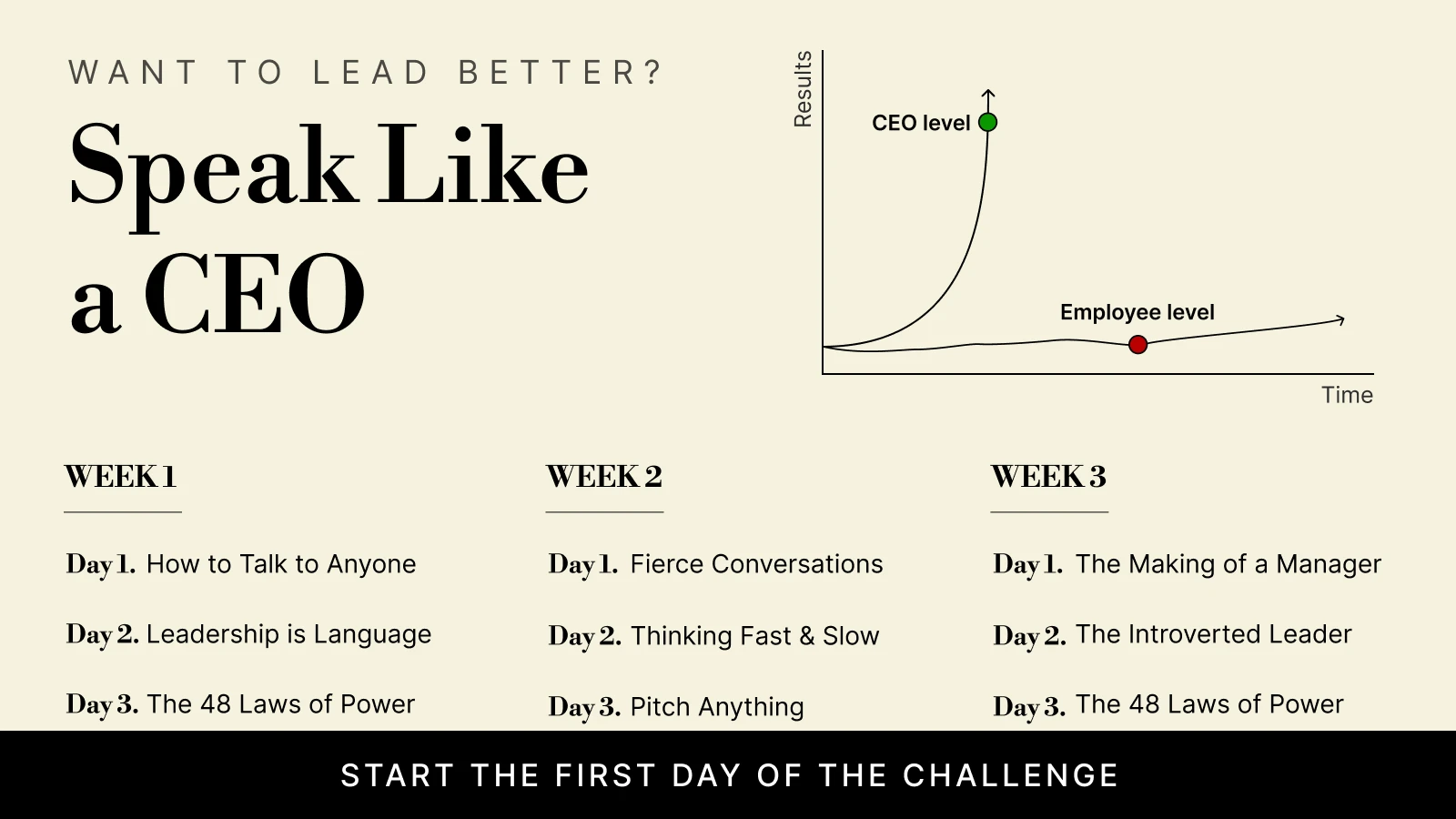Ready to own the room like a chief executive? Speaking like a CEO goes beyond mere words; it's about igniting inspiration within yourself and your team. While straightforwardly delivering clear messages is crucial, it often requires consistent practice. Understanding the psychological nuances of motivational communication is key.
In this article, we'll uncover industry experts' secrets for commanding attention and getting results that will enhance your speaking skills and seamlessly align them with your company's strategic vision. Let's discover the leader within you!
Start with the "Are you a master communicator?" test
Before diving into the essential communication skills every CEO should have, let's take a moment to evaluate your current abilities. Here's a quick interactive test to help you measure your communication prowess. Simply answer "yes" or "no" to each question:
1. Do you find it easy to spark conversations with the people you've just met?
2. Are you an attentive listener and adept at asking "the right" questions?
3. Can your communication style adapt to different settings and personalities?
4. Do you express your thoughts and opinions with clarity and persuasion?
5. Can you navigate conflicts and reach compromises?
6. Do you handle criticism and negative feedback gracefully?
Now, let's tally up your score! Give yourself 1 point for each "yes."
If you scored 4-6 points, congratulations! Your conversation skills are of Abraham Lincoln's level! But remember — there's always room for growth. Consider reading personal development books (or their short summaries on Headway) and taking courses to hone your abilities.
If you scored 2-4 points, you're on the right track but could benefit from some improvement. Consider taking on the leadership reading list challenge presented below.
If you scored 2 points or less, It's time to take action! Focus on your communication skills by drafting a personal progress schedule (including time for studies and practice) to set your feet on the "CEO-level" path.
Keeping yourself challenged every day is key to becoming a better speaker! Be open to the challenges that come your way, and you'll see yourself grow stronger and more confident in the art of public speaking.
Mastering effective communication in modern times
Effective communication lies at the heart of successful leadership. By sharpening their communication skills, high-EQ (emotional intelligence) CEOs can energize their employees, spark innovation, and turn ambitious goals into reality. To help you master these skills, the Headway team has drawn from several outstanding experts who have explored the art of communication and influence in both personal and professional settings:
1. 'How to Talk to Anyone' by Leil Lowndes
Leil Lowndes's 'How to Talk to Anyone,' published by McGraw-Hill Education, is particularly notable for its practical tips on making lasting impressions and building strong connections. This bestseller is full of social strategies that can enhance your interactions.
2. 'Leadership Is Language' by L. David Marquet
L. David Marquet's 'Leadership Is Language' by Portfolio Penguin emphasizes the significant role of language in fostering a team culture that encourages ownership and initiative. It challenges traditional command-and-control leadership styles and promotes a more inclusive approach toward stakeholders.
3. 'The 48 Laws of Power' by Robert Greene
Robert Greene's 'The 48 Laws of Power' offers an intriguing exploration of power dynamics, filled with tactical strategies for navigating complex social landscapes. It's a thought-provoking executive coaching read that helps you understand the subtleties of influence.
4. 'Never Split the Difference' by Chris Voss
From a practical standpoint, Chris Voss's 'Never Split the Difference' shares invaluable negotiation tips from his extensive experience with US federal criminal cases. While using witty remarks to keep your reader's mood light, the author introduces practical insights on conflict resolution and trust-building, which are critical for effective communication.
5. 'Crucial Conversations: Tools for Talking When Stakes Are High' by Kerry Patterson, Joseph Grenny
In the sphere of impactful communication, ‘Crucial Conversations: Tools for Talking When Stakes Are High’ by Kerry Patterson, Joseph Grenny, Ron McMillan, and Al Switzler offers indispensable strategies for navigating difficult conversations. This bestselling guide focuses on handling high-stakes discussions where emotions run high and opinions differ, equipping readers with the skills to maintain dialogue, build trust, and achieve constructive outcomes. It’s a transformative resource for improving relationships and driving positive change in both personal and professional settings.
6. 'Thinking, Fast and Slow' by Daniel Kahneman
Daniel Kahneman's 'Thinking, Fast and Slow' by Penguin explores human cognition, illustrating how our biases and stereotypes can shape our thought processes. Understanding these concepts is crucial for improving decision-making and judgment.
7. 'Pitch Anything' by Oren Klaff
If you are looking to enhance your presentation skills, consider Oren Klaff's 'Pitch Anything' by McGraw Hill. The author introduces a robust framework for delivering compelling pitches that effectively engage and persuade audiences.
8. 'The 5 Levels of Leadership' by John Maxwell
Finally, John Maxwell's 'The 5 Levels of Leadership' by Center Street presents an insightful model for leadership development, highlighting the importance of trustworthiness and an authoritative tone to inspire and elevate those around you.
Each of these books is filled with valuable concepts that can transform how you communicate and lead. Whether you aim to improve personal interactions or enhance your leadership abilities, checking these titles and using them to challenge yourself to grow as a communicator will speed up your "speak like a CEO" journey.
Discover the strategic communication kit of successful CEOs
The secrets of c-suite business leaders in communicating their vision, building connections, and addressing business challenges are not too elaborate. This toolkit outlines the fundamentals of tried-and-true techniques — clear messaging, undivided attention, and adaptive tone — that enable a positive workplace culture.
Clarity and simplicity
Think of communication as a sharp tool: the more concise you are, the more effective you'll be as a CEO. Leadership thrives on quick, clear communication. As you deliver your message with clarity, make sure to maintain eye contact to engage your audience and emphasize your points. Just like a top-level keynote speaker or prime-time news anchor, use simple language to cut the clutter from your messages. This way, your words will influence people, whether in person or through instant messaging and maintain your executive presence.
Confidence and non-verbal reading
Confident CEOs radiate an aura of self-assurance that naturally commands respect. But effective executive communication goes even further; it tunes into unspoken signals like body language and facial expressions that often speak volumes. By studying others and maintaining an open, authentic demeanor, you create a welcoming atmosphere that sets the stage for impactful leadership aligned with your organization's purpose.
Active listening and respectful tone
Effective communication hinges on one essential skill: the ability to listen. Think about past conversations — how often did you find yourself zoning out or waiting for your turn to speak instead of genuinely absorbing what others were saying? When leaders prioritize listening, asking insightful questions, and offering inspiring feedback, they spark respect and foster collaboration, significantly enhancing team dynamics.
Inspiring communication and productive conflict
Exceptional CEOs constantly showcase their remarkable leadership skills by vividly bringing their organization's vision to life. They communicate in ways that embody company core values, creating an environment where every team member feels invested and motivated. Navigating conflicts is equally essential; you nurture a collaborative atmosphere by addressing disagreements with poise and transparency. Remember: it is not the CEO and the team against each other, but both of you against the problem.
Practice these skills to progress in CEO-level communication
Being a concise speaker, perceptive listener, and charismatic conflict moderator forms the core of effective CEO communication. To further boost your progress, focus on understanding your audience, showing empathy in every situation, being creative in interactions, and eagerly seeking employee feedback:
Know your audience: When you customize your message to resonate with your audience, you're not just sharing ideas; you're building meaningful connections. As Voss admits in 'Never Split the Difference,' empathy is crucial in this process, enabling you to relate to your team emotionally. A leader who expresses empathy can navigate challenging moments while offering support and understanding.
Be an innovative storyteller: Use storytelling to make your in-person messages and social media publications more memorable. A good CEO thinks outside the box and welcomes innovation. In 'The 48 Laws of Power, ' Greene hints that embracing these qualities will encourage your team to tap into their creative strengths and support new solutions that help the organization stay ahead of its competitors.
Seek feedback: To speak like a CEO, you should genuinely value your coworkers' input, recognizing that every team member has insights to enhance the organization. As you can learn from 'How to Talk to Anyone' by Lowndes and Maxwell's '5 Levels of Leadership,' encouraging open dialogue and teamwork boosts morale and inspires unique ideas and accomplishments.
The way a CEO communicates is essential to their leadership style. Combining audience-focused decision-making with understanding people's thoughts and feelings can go a long way in fostering a company's success.
Recommended readings to enhance communication skills
If you're enthusiastic about enhancing your communication skills, the Headway Team has an exciting Two-Week Reading Challenge! Read one Headway's book summary each day from Monday to Thursday. Dive into the practical advice from renowned experts to explore new techniques and refine your communication powers. Are you ready to take your skills to the next level?
Week 1
Monday: 'How to Talk to Anyone' by Leil Lowndes
In 'How to Talk to Anyone,' Lowndes emphasizes genuinely listening when someone is speaking instead of planning what you want to say next. She suggests matching the other person's body language for instant connection:
"Deciding to pursue my own agenda for How to Talk to Anyone, I asked, 'Bob, if you wanted to portray somebody really cool — you know, intelligent, strong, charismatic, principled, fascinating, caring, interested in other people ... 'Easy,' Bob interrupted. He knew precisely what I was getting at. Just give 'em great posture, a heads-up look, a confident smile, and a direct gaze.'"
As a CEO who uses these techniques, you will get a work environment full of teamwork, mutual empathy, and strong interpersonal connections.
Tuesday: 'Leadership Is Language' by L. David Marquet
Moving on to Marquet's 'Leadership is Language,' he reveals how a CEO's words can shape an organization's culture and team collaboration. He suggests that leaders should encourage and empower their teams through supportive dialogue instead of using strict command language.
"In brainstorming, I would like as many different ideas as possible. In decision-making, I would like a wide range of options. In determining the truth, I would like to hear different perspectives."
When delivering a speech, highlight the importance of shared responsibility and collective commitment to your company's future to foster a stronger sense of community among your team members.
Wednesday: 'The 48 Laws of Power' by Robert Greene
In 'The 48 Laws of Power,' Greene explores using communication to establish authority in various corporate situations. He shares the necessary strategies for maintaining boundaries in relationships effectively:
"Never assume that the person you are dealing with is weaker or less important than you are. Some people are slow to take offense, which may make you misjudge the thickness of their skin, and fail to worry about insulting them. But should you offend their honor and their pride, they will overwhelm you with violence that seems sudden and extreme, given their slowness to anger. If you want to turn people down, it is best to do so politely and respectfully, even if you feel their request is impudent or their offer ridiculous."
Decisive leadership is about taking responsibility for the outcomes of your choices. Every decision you make creates waves that affect not only the current situation but also the future. When challenges arise, you demonstrate your integrity as a CEO by communicating with resilience and accountability. Understanding these tactics will help you grow your negotiating competency and problem-solving ability to move on to the next goal.
Thursday: 'Never Split the Difference' by Chris Voss
Drawing from his FBI hostage negotiation experience, Voss shares valuable negotiation instruments for corporate settings in 'Never Split the Difference.' He emphasizes the importance of reading emotions and showing empathy in negotiations. Improving your EQ can transform the way you draft and deliver speeches. By honing this skill, you'll become more persuasive and master the perfect tone and timing to win your colleagues over:
"Negotiate in their world. Persuasion is not about how bright or smooth or forceful you are. It's about the other party convincing themselves that the solution you want is their own idea. So don't beat them with logic or brute force. Ask them questions that open paths to your goals. It's not about you."
Applying Voss's advice will turn challenging conversations into mutually beneficial outcomes.
Week 2
Monday: ‘Crucial Conversations’ by Kerry Patterson, Joseph Grenny, Ron McMillan, and Al Switzler
The book 'Crucial Conversations' underscores the power of open and respectful dialogue in high-stakes situations where opinions differ and emotions run high. It encourages leaders to create environments where challenging topics can be addressed constructively, ensuring everyone feels valued and heard.
"At the heart of every failed conversation lies either the avoidance of crucial issues or an emotional reaction that derails the discussion. Mastering the skills of crucial conversations is about finding a path forward, even when it’s tough."
By fostering a culture of open communication, organizations can enhance collaboration, resolve conflicts effectively, and drive progress. The authors' practical tools empower individuals to navigate difficult conversations with confidence, creating space for authentic dialogue and innovative solutions.
Tuesday: 'Thinking, Fast and Slow' by Daniel Kahneman
Kahneman's 'Thinking Fast and Slow' offers an intriguing perspective on how the mind works and how certain biases can shape decision-making:
"We can be blind to the obvious, and we are also blind to our blindness."
Kahneman's advice helps CEOs recognize mental traps, including downplaying the strategic value of their decisions, to help their organization succeed while avoiding costly mistakes.
Wednesday: ‘Daring Greatly’ by Brené Brown
Brené Brown’s ‘Daring Greatly’ delves into the transformative power of vulnerability of the company’s top executives in building trust, fostering creativity, and strengthening connections. The book challenges conventional notions of strength, showing how embracing vulnerability can lead to greater courage and authentic leadership.
“Vulnerability is not about winning or losing; it’s having the courage to show up when you can’t control the outcome.”
Applying Brown’s insights can help you lead with authenticity and inspire your team to take meaningful risks.
Thursday: 'The 5 Levels of Leadership' by John Maxwell
Maxwell's '5 Levels of Leadership' outlines a clear path through different stages of your personal growth as a speaker. The author highlights the importance of integrity, empowering others, and serving your team as key qualities of effective leadership.
"When people follow a leader because they have to, they will do only what they have to. People don't give their best to leaders they like least. They give reluctant compliance, not commitment. They may give their hands but certainly not their heads or hearts."
By verbally appreciating the employees' initiatives and perspectives, you can advance your team's potential, guiding their talents to elevate individual performance and drive sustainable success for the entire organization. For further progress, consider listening to international and local podcasts and media interviews of charismatic CEOs and reading their LinkedIn posts to learn more about unique leaders' styles and approaches.
Bonus recommendation
In 'Pitch Anything,' 'Klaff shares strategies for impactful communication, especially when under pressure. Klaff provides tips on engaging and keeping audiences focused on you, making a strong case for new product pitches and proposals. Top executives who master these skills can confidently present their visions and inspire others to follow in their footsteps. As a training practice, the Headway Team suggests applying the STRONG framework by Klaff when preparing your speech for an upcoming meeting.
The STRONG framework: Level up your persuasion power as a speaker
S - Setting the frame: Establish a compelling context that captures attention and sets the tone.
T - Telling the story: Choose engaging narratives to forge an emotional connection with your audience and make your message relatable and impactful.
R - Revealing the intrigue: Keep curiosity alive and maintain interest by revealing just enough to keep your colleagues wanting more.
O - Offering the prize: Frame your pitch as an exciting chance they can't afford to miss by highlighting its value.
N - Nailing the hook point: Create a strong hook that inspires your audience to take action, leading them toward a decision point desirable for you as a CEO.
G - Getting a decision: Encourage a clear-cut outcome by asking for a definitive response — whether it's a yes, a no, or a request for a follow-up.
Leveling up your personal development and speaking skills with Headway
Headway makes learning easy and fun by providing short, insightful summaries of leading leadership books. With Headway, you can quickly pick up crucial ideas without spending much time, helping you improve your communication skills along the way.
For example, in 'How to Talk to Anyone,' you discover how to connect with people and build trust by genuinely listening and using positive body language. If you want to motivate your team, 'Leadership is Language' teaches you how your words can inspire those around you. For tough negotiations, 'Never Split the Difference' shares smart strategies to help you get the best results. And if you want a frank and deep dialogue, 'Fierce Conversations' by Susan Scott offers helpful tips for open and fruitful discussions.
To enhance your leadership communication skills and embrace the "speak like a CEO" journey, explore the reading lists curated by the Headway Team and inspired by great leaders. These 15-minute book summaries provide solid insights into practical leadership principles, helping you refine your style and connect authentically with your team. Use these resources to identify your leadership approach, navigate challenges, and inspire others while nurturing your company's potential.
FAQ
How do you talk like a CEO?
To talk like a CEO, focus on being clear, confident, and concise. Use direct language, speak with intention, and avoid filler words — strong communication is often about saying more with less.
How to talk like an executive?
Talking like an executive means speaking strategically. Stay calm under pressure, tailor your message to your audience, and emphasize impact and vision. Executives often ask smart questions and frame ideas around solutions.
How to act like a CEO?
Acting like a CEO involves showing leadership through presence, decision-making, and accountability. CEOs are typically proactive, emotionally intelligent, and solution-focused — they take ownership, inspire confidence, and lead by example.
How do CEOs speak so well?
CEOs speak well because they prepare, practice, and prioritize clarity. Many work with communication coaches or develop their skills over time through high-stakes conversations, public speaking, and media training.











